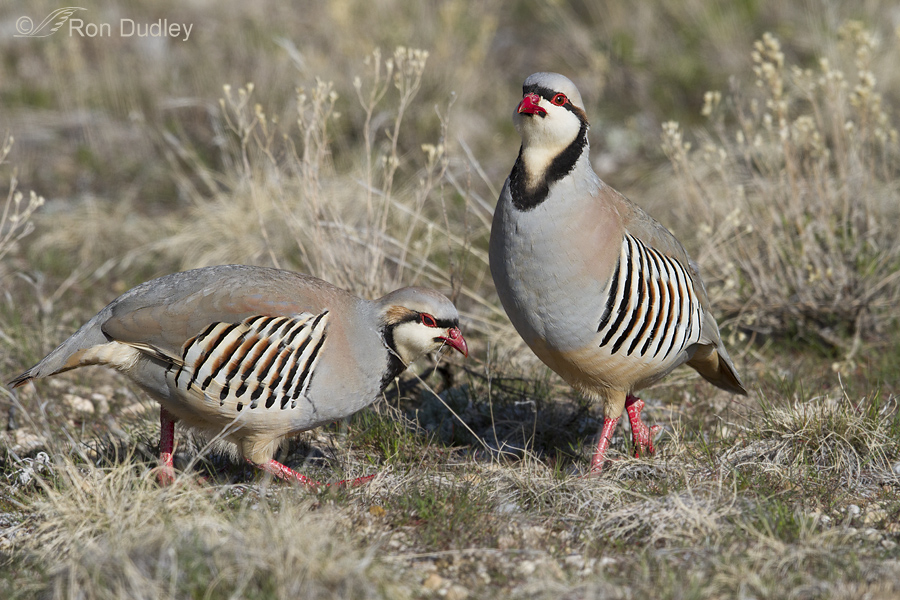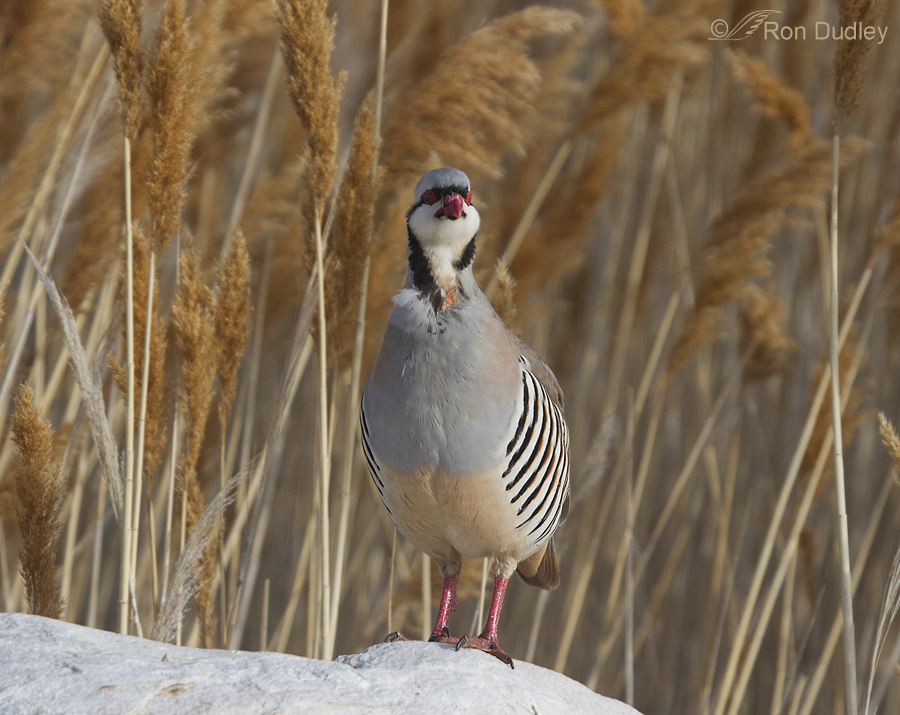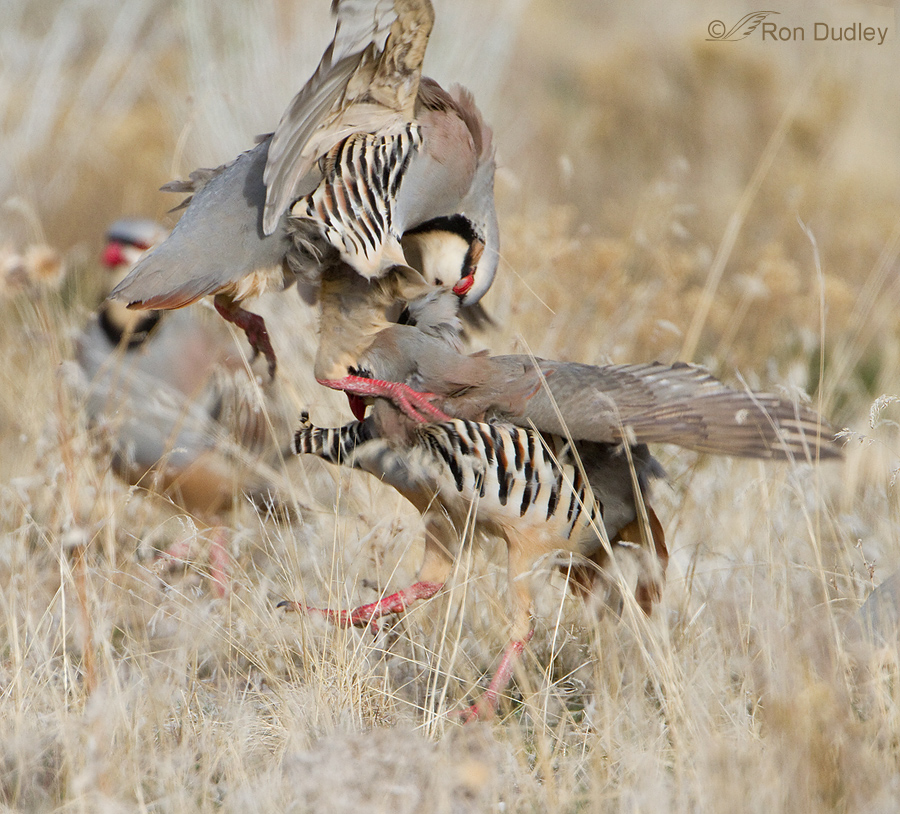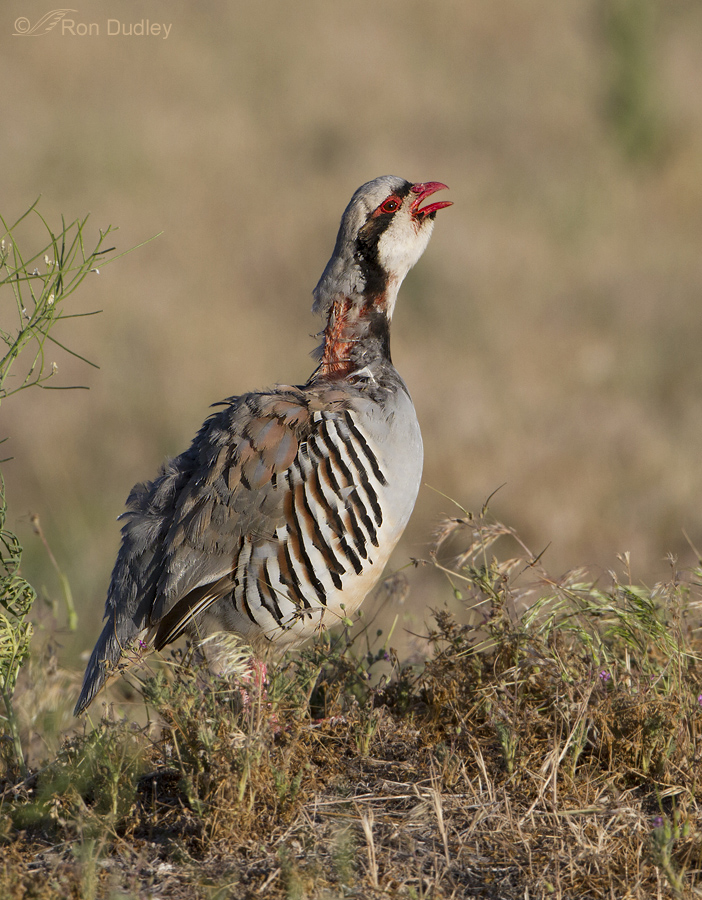Springtime fights between male Chukars can be vicious affairs that sometimes leave the participants looking like they’ve stepped on a land mine.

Chukars form pair bonds in the spring and I photographed this obviously mated pair two days ago on Antelope Island. This time of year their plumage is fresh and handsome as you can see with these contrasting poses of both birds. But males become extremely aggressive toward other males who enter their nesting territory or approach their females and the resulting fights can really make a mess of their feathers.

This apparent male, photographed on the same day, shows some of the scars of war on its neck.

Their fights can be truly epic. The action is extremely fast, furious and difficult to photograph but this image should give you a flavor for its intensity. Notice that the top bird has a firm grip on a beak-full of its opponents neck feathers and feathers were flying during the altercation. I’ve posted these last two images before but they’re the best images I have to illustrate the behavior and its results (prepare yourself, this last shot isn’t pretty…).

This is the most battle-scarred Chukar I’ve ever seen. The image was taken in the second week of June which is earlier than Chukars on the island generally molt so I’m relatively sure this isn’t some bizarre molting pattern in this individual bird (though that’s what I suspected when I first posted this image last year). I very much doubt it’s the result of disease as this bird seemed vigorous and healthy – as you can see he’s calling enthusiastically and apparently spoiling for another fight.
Just looking at this poor bird makes my eyes water…
Ron


Thanks for the warning, that was a shock. Would they go so far as to kill another suitor?
Ouch! Indeed. Your chukars are not unlike Australian native pigeons and I’m wondering if there are other similarities…a few years ago, friends and I witnessed similar mating fights and one young cock who seemed to have missed finding a mate continued to approach even after eggs were laid.And continued to be beaten off. Perhaps your scruffy fellow was such a bird? And perhaps, next Spring, he got an early start.A bit like the lads coming late to the Saturday dance-the next week they were first on the dance floor!
Testoserone poisoning? Do birds get it too? That third shot is, as you say, amazingly intense – small creatures but big hearts. Thanks again.
Ouch. A perfect illustration of ‘pecking order’. Though that bird looks as if he considers himself the victor – a triumpant ‘you should see the other guy’ sort of thing.
And we do worse to each other (and to other species). Daily.
We had an abused rescue Lhasa Apso, named Norton (we called “Snort” or “Short Snort”). Snort didn’t like feet (we think he was kicked) or my wolf-dog, Kola He used to bug Kola la, until the big guy got sick of him and would finally knock Snort down, roll him onto his back, press his teeth into Snort’s jugular vein and make horrible assassination sounds. I dreaded these episodes, expecting fur to fly, blood to spurt all over everything and a dead body to deal with (I have a real aversion to dead bodies), but there was never any damage done. When it was over, Kola would get up, roll his eyes at me, and walk away. Snort would assess whether he was dead or alive, get up, shake vigorously and strut around as if to say, “You got away easy this time. Next time you may not be as lucky,”. I’m beginning to wonder if Snortman may had a little Chukar blood in him….think it’s possible???
It does indeed sound as if he had a bit of beagle boy blood in him.
Both of our cats are rescue cats. Jazz has a HUGE fear of white vans. I am sure there is a story to it. Probably an ugly story about someone emerging from one of those vans…
We had a beautiful, sweet yellow lab rescue tat was terrified of station wagons…makes you wonder….
I wonder what the other guy looked like! Who knew these ELEGANT CLOWNS could do such damage to each other….Do they stay moth eaten or do the feathers grow back…all I can picture is a flock of half bald birds….
That poor bird!! Could that birdrecover from that attack? Could the feathers grow back? Doesn’t look like he could fly. Nature can be so cruel.
I suspect the bird was just fine after it molted, Ellen. These guys don’t fly much anyway.
I have a bit of a love affair for Chukars, so I find this post very intriguing. Though, that last photo shook me up a bit. As always, thanks for the lesson. I always learn something from you.
Yeah, that last one’s not easy to look at. Thanks for the comment about “learning”, Lisa.
Amazing shots Ron! Thanks so much for sharing!
Charlotte
Good heavens … poor birdies!!! Amazing images, Ron!!
Thanks, Lois.
Glad you like them, Charlotte.